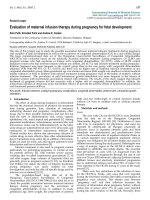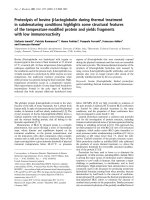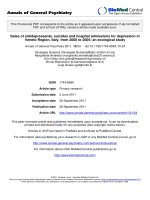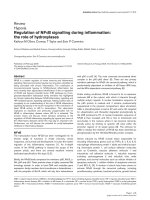Báo cáo y học: "Evaluation of maternal infusion therapy during pregnancy for fetal development"
Bạn đang xem bản rút gọn của tài liệu. Xem và tải ngay bản đầy đủ của tài liệu tại đây (286.23 KB, 6 trang )
Int. J. Med. Sci. 2005 2
137
International Journal of Medical Sciences
ISSN 1449-1907 www.medsci.org 2005 2(4):137-142
©2005 Ivyspring International Publisher. All rights reserved
Research paper
Evaluation of maternal infusion therapy during pregnancy for fetal development
Dóra Petik, Erzsébet Puhó and Andrew E. Czeizel
Foundation for the Community Control of Hereditary Diseases, Budapest, Hungary
Corresponding address: Dr. Andrew E. Czeizel, 1026 Budapest, Törökvész lejtő 32. Hungary. e-mail:
Received: 2005.08.01; Accepted: 2005.08.26; Published: 2005.10.01
The aim of this project was to study the possible association between maternal infusion treatments during pregnancy
and variables of fetal development as well as the occurrence of congenital abnormalities (CA) in a case-control design.
The large population-based data set of the Hungarian Case-Control Surveillance of Congenital Abnormalities
(HCCSCA) was evaluated based on the medically recorded infusion treatment during pregnancy. Of 22,843 case
pregnant women who had newborns or fetuses with congenital abnormalities, 112 (0.5%), while of 38,151 control
pregnant women who had newborn infants without any defects, 262 (0.7%), had infusion treatment during pregnancy.
Infusion treatment was more frequent in the control group than in the case group with congenital abnormalities
(adjusted POR with 945 95% CI: 0.7, 0.6-0.9) and there was no higher rate of maternal infusion treatments in any
congenital abnormality group. Mean gestational age was shorter and mean birth weight was smaller in control newborn
infants without CA born to mothers with infusion treatment during pregnancy than in the babies of mothers without
infusion treatment. The prevalence of mild intrauterine growth retardation was more frequent in the fetuses of
pregnant women with hyperemesis gravidarum treated with infusion. The results of the study suggest that infusion
treatment of pregnant women did not associate with a higher risk of congenital abnormalities. In addition, the
intravenous infusion of drugs has some, but limited efficacy to prevent the adverse effects of hyperemesis gravidarum
and threatened preterm delivery.
Key words: Infusion treatment, underlying pregnancy complications, congenital abnormalities, preterm birth, intrauterine growth
retardation.
1. Introduction
The effect of drugs during pregnancy is determined
beyond the chemical structure of product, the treatment
time during gestation, dose, duration of treatment,
underlying diseases and pregnancy complications, other
drugs due to their possible interaction and last but not
least the type of administration: oral, rectal, vaginal,
ophthalmic, otic, nasal, topical and parenteral [1]. Among
parenteral medications, subcutaneous, intramuscular and
intravenous routes can be differentiated [2]. In the latter
some drugs are administered at once or by slow push, and
continuous or intermittent intravenous infusion [3].
Clinical studies have shown that intravenous infusion of
certain drugs is more effective than other administrations
due to immediate drug action [4]; in addition, intravenous
fluids are used for many sick and injured patients to treat
dehydration and loss of electrolytes [5].
Infusion treatment is also used in pregnant women
particularly for prolonging pregnancy in women at risk
for preterm delivery [6], with extreme severe nausea-
vomiting (the so-called hyperemesis gravidarum) [7, 8]
and after surgery large volumes of hypotonic fluid are
generally given to pregnant women [9, 10]. As Friedman
and Polifka [11] stated, the effect of infusion treatments
during pregnancy was rarely studied for fetal
development, and only the effect of specific drugs used by
infusion was evaluated [12,13].
The population-based large data set of the
Hungarian Case-Control Surveillance of Congenital
Abnormalities (HCCSCA 1980-1996) [14] is ideal for us to
check the possible association between maternal infusion
therapy during pregnancy and the occurrence of
congenital abnormalities (CAs), in addition to study
gestational age, birth weight, the proportion of preterm
birth and low birthweight in control newborn infants
without CA born to mothers with or without infusion
therapy.
2. Materials and methods
Cases
The cases with CAs for the HCCSCA were identified
from the data set of the Hungarian Congenital
Abnormality Registry (HCAR) [15]. Notification of cases
with CAs is compulsory for physicians, and most are
reported by obstetricians (in Hungary practically all
deliveries occur in inpatient obstetric units and birth
attendants are obstetricians) and paediatricians (who
work in the neonatal units of inpatient obstetric clinics or
in various inpatient and outpatient paediatric clinics).
Autopsy was obligatory for all infant deaths and usual in
stillborn fetuses during the study period. Pathologists sent
a copy of autopsy report to the HCAR if defects were
identified in stillbirths and infant deaths. The recorded
total prevalence of cases with CA diagnosed from the
second trimester of pregnancies through the age of one
year was 35 per 1000 informative offspring (liveborn infants,
stillborn fetuses and electively terminated pregnancies
due to malformed fetuses) and about 90% of major CAs
were reported to the HCAR during 17 years of the study
period [15].
There were two restrictions at the selection of cases
for the HCCSCA. Firstly, only cases that were reported
during the first three months after birth or termination of
pregnancy were selected. This shorter time between
“pregnancy end” and data collection increases the
accuracy of information about pregnancy history without
undue loss of power since 77% of cases were reported
during this time window to the HCAR. Secondly, three
Int. J. Med. Sci. 2005 2
138
mild CAs (such as congenital dislocation of hip based on
Ortolani click, congenital inguinal hernia, and large
haemangioma), minor anomalies-variants (e.g., umbilical
hernia, hydrocele, small haemangioma) and
CA-syndromes of known Mendelian or chromosomal
origin were excluded.
Controls
Controls were defined as newborn infants without
CAs and they were selected from the National Birth
Registry of the Central Statistical Office for the HCCSCA.
In general, two control newborn infants were matched to
every case according to sex, birth week, and district of
parents' residence.
Collection of exposure data
Exposure data were obtained from the following
three sources: (i) Retrospective maternal self-reported
information. A post-paid questionnaire, explanatory letter
along with a list of medicinal products (drugs and
pregnancy supplements) and diseases, and a printed
informed consent were mailed immediately after the
selection of cases and controls to the mothers. The
questionnaire requested information, among others, on
medicinal product intakes, pregnancy complications,
maternal diseases and treatments including infusion
during pregnancy according to gestational month. To
standardize the answers, mothers were asked to read the
enclosed lists of drugs and diseases before they replied. In
addition, mothers of cases were asked to give a signature
for the enclosed informed consent which authorised us to
record their name and address. (ii) Prospective medically
recorded data. Mothers were also asked to send us the
antenatal care logbook and discharge summaries of
hospitalisation during pregnancy together with the filled-
in questionnaire and signed informed consent. The mean
± S.D. time elapsed between the pregnancy end and return
of the data package was 3.5 ± 1.2 and 5.2 ± 2.9 months in
the groups of cases and controls, respectively. (iii)
Supplementary data collection in non-respondent
mothers. Regional district nurses were asked to visit and
to question all no respondent mothers of cases and 200 no
respondent control mothers at home. Regional nurses
used the same questionnaire through a personal interview
and evaluated the available medical records. District
nurses did not visit all no respondent control mothers
because the ethical committee considered this follow-up to
be disturbing to the parents of these healthy children [16].
Thus, information was available on 96.3% (84.4% from
reply, 11.9% from visit) of cases and on 83.0% (82.6% from
reply, 0.4% from visit) of controls. Data from the
antenatal care logbook were available in 88.4% of cases
and in 93.8% of controls. The informed consent document
was signed by 98.4% of case mothers. Personal identifiers
(i.e. name and address) were deleted from the record of
cases if their mothers did not give informed consent keep
them. The personal data of controls are not recorded in
the HCCSCA.
The fourth step was the evaluation of maternal
infusion in five different aspects.
1) The source of information. All infusion treatments
were medically recorded in the discharge summary,
because pregnant women with severe nausea-vomiting
and threatened preterm delivery were hospitalized.
2) Medication used through infusion and the intake of
other drugs. Pregnancy supplements (such as calcium,
iron, and vitamins) and infusion used for labour induction
were excluded from this analysis.
3) Time of infusion according to gestational age.
Gestational age was calculated from the first day of last
menstrual period and three time intervals were
considered: (i) the first month of pregnancy, which is
before organogenesis; (ii) the second and third months of
gestation, considered the most sensitive, and the so-called
critical period for most major CAs; and (iii) the fourth to
ninth months of gestation. If pregnant women had
infusion twice or more during the study pregnancy, only
one treatment was analysed according to the following
priority: 2-3, 1, 4-9 months.
4) Gestational age and birth weight were analysed in
newborn infants of control mothers with or without
infusion treatment. These variables were also medically
recorded. Cases with CAs were excluded from this
analysis because CAs may have a more drastic effect for
these variables than infusion treatment.
5) Potential confounding factors, as maternal age, birth
order, marital and employment status of mothers (as
indicators of socioeconomic status), pregnancy
complications and drug uses were evaluated.
Statistical analysis
Results were analysed with the SAS version 8.02
statistical software package (SAS Institute Ins., Cary,
North Caroline, USA). First, the prevalence of infusions
was compared between the study groups and crude
prevalence odds ratios (POR) with 95% confidence
interval (95% CI) were calculated. Second, quantitative
confounders such as maternal age, birth order, were
compared using Student t test while POR with 95% CI
were calculated for marital status and chi square test for
employment status. Third, pregnancy complications were
compared between case and control groups in
unconditional logistic regression model. Fourth, the
distribution of gestational age according to the infusion
treatment was evaluated using chi square test. Fifth, the
prevalence of maternal infusion treatment in 24 CA-
groups was compared with the frequency of this
treatment in their all matched controls and adjusted POR
with 95% CI for potential confounders were evaluated in a
conditional logistic regression model. Sixth, the
prevalence of maternal infusion treatment in the CA-
groups was compared with the prevalence of this
treatment in total controls as reference using
unconditional logistic regression model. Finally, mean
birth weight and gestational age of control newborn
infants born to mothers with or without infusion
treatment were compared in linear logistic regression
model, while the proportion of preterm birth and low
birthweight were compared in unconditional logistic
regression model.
3. Results
During the study period, 2,146,574 babies were born
in Hungary; therefore 38,151 controls represented 1.8% of
the Hungarian births. In the control group, 262 (0.69%)
pregnant women had infusion. The case group consisted
of 22,843 malformed offspring and 112 (0.49%) pregnant
women were treated by infusion during pregnancy. Thus
the infusion treatment was less frequent in the case group
(adjusted POR with 95% CI: 0.7, 0.6-0.9).
The characteristics of mothers are shown both in
total and infusion treated case and control groups in Table
Int. J. Med. Sci. 2005 2
139
1. It is worth mentioning that pregnant women with
infusion were younger with lower birth order than the
mothers in the total groups. Mean maternal age did not
show significant difference between case and control
pregnant women with infusion, while the mean birth
order was lower in the group of case mothers with
infusion. There was no obvious difference in the
proportion of unmarried women and in the distribution of
employment status between case and control mothers
with infusion.
The prevalence of pregnancy complications is shown
in Table 2. These data reflect the three main reasons of
maternal infusion: (i) threatened preterm delivery in
about half of mothers; (ii) hyperemesis gravidarum; and
(iii) surgical interventions. In addition, there was a higher
prevalence of threatened abortions in the mothers with
infusion compared with the mothers of total groups.
However, there was no significant difference in the
prevalence of pregnancy complications between the case
and control groups with infusion.
The distribution of infusion according to the month
of gestation in the case and controls groups is shown in
Table 3. There were two peaks of infusion treatments. The
first peak was connected with the treatment of
hyperemesis gravidarum in the second and third months
of gestation. The reason of second peak in the infusion
treatments can be explained by threatened preterm
delivery in the seventh and eighth month of gestation.
Mothers with surgical interventions are not evaluated
here because these pregnant women were evaluated
previously (10). As we previously mentioned, labour
induction was also excluded from this analysis. There was
no significant difference in the monthly distribution of
infusions between controls and cases (χ
2
8
=7.55; p=0.48)
and in the frequency of infusion during the second-third
months of pregnancy (χ
2
1
=0.4; p=0.51).
The reason of infusion for hyperemesis gravidarum
was fluid replacement combined with oral treatment of
thiethylperazine, dimenhydrinate and vitamin B6. In
general Saletanol D5
®
solution (sodium chloride 4.5 g,
glucose 50 g and alcohol 50 g in 1000 ml solution with a
speed of 30-40 drops/min which means 0.19/bw/hour of
alcohol) or Ringer lactate
®
solution (sodium chloride 5.55
g, potassium chloride 0.3 g, calcium chloride 0.28 g,
magnesium chloride 0.09 g, sodium lactate 5.04 g in 1000
ml with a speed of 120-150 drops/min) were used for this
treatment. The reason of infusion for threatened preterm
delivery was the so-called tocolysis, terbutaline
(Bricanyl
®
) (5 mg per 1000 ml isotonic sodium chloride
solution, 1 ml contains 5 µg for 8 h with a starting speed of
10 µg/min contained by 5 µg/min) and fenoterol
(Partusisten
®
) (0.5 mg per 250-500 ml 5% glucose solution
with a speed of 0.5-3.0 µg/min) were used for this
purpose sometimes combined by verapamil (Verapamil
®
).
The occurrence of other frequently used drugs
(antibiotics, analgesics, etc.) did not show significant
differences between case and control mothers with
infusion.
The prevalence of infusion in 14 CA-groups
(including 2 or more cases) was compared with the
frequency of infusion in their all matched controls and
adjusted POR with 95% CI for confounding factors were
calculated in conditional logistic regression model (Table
4). There was no a higher prevalence of infusion during
the study pregnancy in any CA-groups. On the other hand
the maternal infusion during the study pregnancy showed
a lower occurrence in two CA-groups: hypospadias and
multiple CAs (which include heterogeneous CA-entities).
Thus, the adjusted POR with 95% CI for the prevalence of
infusion was also lower in the total group of cases with
CAs. It is worth focusing the second and third months of
gestation, the critical period of most major CAs. We did
not find a higher prevalence of infusion treatment in any
CA group, but the number of case mothers was limited.
The prevalence of maternal infusion treatment in the
CA-groups was compared with the prevalence of this
treatment in the total control group as well. This approach
showed a higher adjusted POR with 95% CI for renal
a/dysgenesis (4.4, 1.4-14.1), however, this possible
association was based on 3 cases and two offspring had
mothers with infusion after the third month of gestation
(i.e. the critical period of this CA-group). The lower
prevalence of infusion in the mothers with children
affected with hypospadias (0.4, 0.2-0.8) and multiple CAs
(0.2, 0.1-0.8) was confirmed.
The distribution of gestational age and birth weight
groups and their mean ± S.D. were evaluated only in
control pregnant women with or without infusion (Table
5). Both gestational age (adjusted t = 5.4, p<0.001) and
birth weight (adjusted t = 7.6, p<0.001) were significantly
lower in pregnant women with infusion than in pregnant
women without infusion. These trends were in agreement
with the higher rate of preterm birth (16.4% vs. 9.1%) and
low birthweight (12.6% vs. 5.6%) of newborn infants born
to mother with infusion.
These differences were more obvious in women who
had infusion in the sixth-ninth month of gestation: mean
gestational age was 38.1 ± 2.6 and 39.4 ± 2.0 week, while
mean birth weight 2,941 ± 529 and 3,277 ± 311 gram in
women with and without infusion, respectively. On the
other hand the mean gestational age (39.4 ± 2.5 vs. 39.4 ±
2.0 week) in control women with or without infusion was
similar between the second and fifth months due to
hyperemesis gravidarum. However, there was a
significant reduction in mean birth weight (3,162 ± 596 vs.
3,276 ± 511 gram) and it was reflected in a higher
proportion of low birthweight (10.4% vs. 5.7%).
4. Discussion
Our study is the first to evaluate the possible
association in general between the effect of maternal
infusion treatments during pregnancy and the different
variables of fetal development. On the one hand, there
was a lower prevalence of maternal infusion in the group
of total CAs, and within them, of hypospadias and
multiple CAs. Thus, we were not able to detect any
teratogenic potential of infusion treatment during
pregnancy. On the other hand, mean gestational age was
shorter and mean birth weight was smaller in control
newborn infants without CA born to mothers with
infusion treatment during the study pregnancy than in the
babies of mothers without infusion treatment. Thus,
infusion of drugs used for the prevention of threatened
preterm delivery seems to have a limited efficacy.
However, the ratio of threatened preterm delivery was 1
in 3.6 among pregnancy complications instead of the ratio
of preterm birth: 1 in 1.8, therefore nearly half of
threatened preterm deliveries was effectively treated,
therefore it was not inefficient. In addition, intrauterine
growth retardation was found in newborn infants born to
mothers with hyperemesis gravidarum on the contrary of
infusion treatments.
Int. J. Med. Sci. 2005 2
140
The strengths of the HCCSCA's data set are (i) the
large and (ii) population-based cohort including 374
pregnant women with infusion treatment (iii) in an
ethnically homogeneous European (Caucasian)
population. (iv) The data of infusion were prospectively
collected and medically recorded, thus recall bias can be
excluded. (v) Cases with CA and their controls without
CAs were matched, (vi) main confounders were known,
(vii) birth weight and gestational age were medically
recorded, and (viii) there was a good validity of CA-
diagnoses due to the results of recent medical
examinations [14]. However, this data set has also
limitations. Though the response rate was similar in
controls (83%) and cases (84%), there was an active follow-
up, i.e. a home visit in all no respondent case mothers but
only in 200 no respondent control mothers. However, the
use of drugs in control mothers with no response did not
differ significantly from the rate of control pregnant
women who responded [16]. Multiple comparison may
produce a statistically significant association (p<0.05) in
every 20
th
estimation because of chance and we explain
the higher occurrence of renal a/dysgenesis after infusion
treatment at the comparison of this CA group with the
total control group by chance. In addition this
possible association was based on 3 cases because only
one was born to the mother who had infusion in the
second month of gestation, i.e. during the critical period of
renal a/dysgenesis. The type of drugs obviously has a
greater impact for fetuses than the route of administration
[17]. Thus it is not possible to evaluate the impact of an
administration route (namely infusion in this study)
without taking into account the different drugs. However,
the major reason of infusion in pregnant women with
hyperemesis gravidarum is the fluid replacement. The
teratogenic potential of antiemetic drugs used in Hungary
parallel with infusion was evaluated previously. A weak
association was found between thiethylperazine and cleft
lip ± palate [18], there was no teratogenic potential of
dimenhydrinate [19], while vitamin B6 showed a
protective effect for cardiovascular CAs [20]. The other
main indication of infusion therapy was threatened
preterm delivery and it was combined with terbutaline,
fenoterol and verapamil. In general the time of this
treatment was the last trimester of pregnancy (i.e. after the
organogenesis). We need further studies to evaluate in
general the efficacy of different drugs according to
administration route in pregnant women.
The intravenous route is used for the administration
of medications when immediate or special drug action is
required due to the severity of pathological conditions.
Nevertheless, a teratogenic potential of infusion treatment
and/or drugs, in addition underlying pregnancy
complications (e.g. dehydration) during pregnancy was
not detectable in our study. The dehydration in
experimental animal (mouse) investigations caused CAs,
particularly isolated cleft palate [21, 22]. In fact, mothers
who had infusion treatment later delivered boys with a
lower risk for hypospadias and multiple CAs. These
unexpected findings need further studies.
The gestational age was shorter and birth weight was
lower in control infants without CA born to mothers with
infusion treatment during pregnancy. These findings may
indicate the limited value of this treatment because these
pregnant women had also a significantly higher
proportion of preterm birth. In addition, babies born to
mothers with hyperemesis gravidarum showed
intrauterine growth retardation on the contrary of
infusion treatment. Similar findings were not found in
women with severe nausea and vomiting during
pregnancy [23].
In conclusion, the results of our study suggest that
infusion treatment of pregnant women did not associate
with a higher risk for CAs. The intravenous infusion of
drugs have some, but limited efficacy to prevent the
adverse effect of hyperemesis gravidarum and threatened
preterm delivery.
Conflict of interest
The authors have declared that no conflict of interest
exists.
References
1. Bánhidy F, Lowry RB, Czeizel AE. Risk and benefit of drug use
during pregnancy. Int J Med Sci 2005; 2: 100-106.
2. Roland M, Tozer TN. Clinical Pharmacokinetics, Concepts and
Applicants, 2
nd
ed. London : Lee and Febiger. 1989.
3. Craig CR, Stitzel RE. Modern Pharmacology, 3
rd
ed. London : Little
Brown and Co. 1990.
4. Rapp PR, Elgert JF, Piecoro JJ. Guidelines for administration of
commonly used intravenous drugs. Drug Intel. Clin Pharmacy 1980;
14: 193-208.
5. Winters RW. Maintain fluid therapy. In: Winter RW, editor. The
Body Fluids in Pediatrics. Boston: Little Brown and Co. 1973: 113-
133.
6. Voelker R. Infusion helps prolong pregnancy. J Am Med Ass 1998;
279: 902-903.
7. Biggs JS. Vomiting in pregnancy. Causes and management. Drugs
1975; 9: 299-306.
8. Walters WA, Humphrey MD. Common medical disorders and their
treatment. Drugs 1980; 19: 455-463.
9. Thomas TH, Morgan DB. Post-surgical hyponatraemia: the role of
intravenous fluids and arginine vasopressin. Br J Surg 1979; 66: 540-
542.
10. Czeizel AE, Pataki T, Rockenbauer M. Reproductive outcome after
exposure to surgery under anaesthesia during pregnancy. Arch
Gynec Obstet 1998; 261: 193-199.
11. Friedman JM, Polifka JE. The Effects of Drugs on the Fetus and
Nursing Infant. Baltimore: Johns Hopkins Univ Press. 1996.
12. Munoz FC, Marco DG, Perez AV, Caracho MM. Pregnancy outcome
in a woman exposed to continuous inthrathecal baclofen infusion.
Ann Pharmacother 2000; 34: 956-957.
13. Budge H, Mostyn A, Wilson V, Khong AM, Symonds ME,
Stephenson T. The effect of maternal prolactin infusion during
pregnancy on fetal adipose tissue development. J Endocrinol 2002;
174: 427-433.
14. Czeizel AE, Rockenbauer M, Siffel Cs, Varga E. Description and
mission evaluation of the Hungarian Case-Control Surveillance of
Congenital Abnormalities, 1980-1996. Teratology 2001; 63: 176-185.
15. Czeizel AE. The first 25 years of the Hungarian Congenital
Abnormality Registry. Teratology 1997; 55: 299-305.
16. Czeizel AE, Petik D, Vargha P. Validation studies of drug exposures
in pregnant women. Pharmacoepid Drug Safety 2003; 12: 409-416.
17. Dent NJ. Implementing International Good Practice. Buffalo:
Interpharm. 1993.
18. Czeizel AE, Vargha P. Case-control study of teratogenic potential of
thiethylperazine, an antiemetic drug. Br J Obstet Gynecol 2003; 110:
497-499.
19. Czeizel AE, Vargha P. A case-control study of congenital
abnormality and dimenhydrinate usage during pregnancy. Arch
Obstet Gynecol 2005; 271: 113-118.
20. Czeizel AE, Puhó E, Bánhidy F, Ács N. Oral pyridoxine during
pregnancy. Potential protective effect for cardiovascular
malformation. Clin Drug Invest 2004; 5: 259-269.
21. Brown KS, Johnston MC, Murphy PF. Isolated cleft palate in A-J
mice after transitory exposure to drinking-water deprivation and
low humidity in pregnancy. Teratology 1974; 9: 151-158.
Int. J. Med. Sci. 2005 2
141
22. Schwetz BA, Nitschke KD, Staples RE. Cleft palates in CF
1
mice after
deprivation of water during pregnancy. Toxicol Appl Pharmacol
1977. 40: 307-315.
23. Czeizel AE, Dudás I, Puhó E. Association between severe nausea and
vomiting during pregnancy and gestational age. Paediat Perinat
Epid 2005; 19: 106-111.
Tables
Table 1. Characteristics of mothers
Cases Controls Variables
Total
(N=22,843)
Infusion
(N=112)
Total
(N=38,151)
Infusion
(N=262)
Comparison between
case and control mothers with
infusion
Continuous Mean S.D. Mean S.D. Mean S.D. Mean S.D. t-test p-value
Maternal age, yr 25.5 5.3 24.3 5.2 25.5 4.9 25.1 5.2 1.34 0.18
Birth order 1.6 1.0 1.3 0.8 1.6 0.9 1.5 0.9 2.31 0.02
Categorical No. % No. % No. % No. % POR 95%CI
Unmarried 1,269 5.6 9 8.0 1,471 3.9 8 3.1 2.8 1.0- 7.4
Employment status
Professionals 1,901 8.3 11 9.8 4,353 11.4 27 10.3
Managerial 4,968 21.8 29 25.9 10,134 26.6 74 28.2
Skilled worker 6,329 27.7 30 26.8 11,690 30.6 77 29.4
Semiskilled worker 3,869 16.9 16 14.3 5,783 15.2 34 13.0
Unskilled worker 1,503 6.6 8 7.1 1,859 4.9 14 5.3
Others 4,273 18.7 18 16.1 4,332 11.4 36 13.7
χ
2
5
= 1.19
p = 0.95
Table 2. Prevalence of pregnancy complications
Cases Controls Comparison between
Total
(N=22,843)
Infusion
(N=112)
Total
(N=38,151)
Infusion
(N=262)
case and control mothers with
infusion
Pregnancy complications
No. % No. % No. % No. % POR 95%CI
Nausea-vomiting (excessive) 1,746 7.6 33 29.5 3,869 10.1 92 35.1 0.8 0.5- 1.2
Threatened abortion 3,501 15.3 39 34.8 6,512 17.1 81 30.9 1.2 0.7- 1.9
Preeclampsia* 1,768 7.7 11 9.8 3,159 8.3 28 10.7 0.9 0.4- 1.9
Threatened preterm delivery 2,603 11.4 53 47.3 5,446 14.3 135 51.5 0.8 0.5- 1.3
Placental disorders 297 1.3 5 4.5 593 1.6 8 3.1 1.5 0.5- 4.6
Anaemia 3,240 14.2 17 15.2 6,356 16.7 48 18.3 0.8 0.4- 1.5
Surgery 67 0.3 4 3.6 91 0.2 12 4.6 0.8 0.2- 2.4
*including hypertension, proteinuria and oedema alone as well
Table 3. Gestational month distribution of infusion (onset) and the name of infusion solution, in addition drugs used for treatment
without infusion due to labour induction.
Gestational month Cases Infusion Controls Infusion
No. % No. %
I. 0 0.0 - 3 1.1 -
II. 18 16.1 Saletanol D5 16,
Ringer lactate 2
43 16.4 Saletanol D5 37,
Ringer lactate 6
III. 12 10.7 Saletanol D5 11,
Ringer lactate 1
33 12.6 Saletanol D5 28,
Ringer lactate 4,
Infusamine 10% 1
IV. 6 5.4 Saletanol D5 3,
Fenoterol 2,
Glucose 20% 1
20 7.6 Saletanol D5 12,
Fenoterol 8
V. 6 5.4 Fenoterol 4,
Terbutaline 2
16 6.1 Fenoterol 10,
Terbutaline 5,
Glucose 20% 1
VI. 13 11.6 Terbutaline 8,
Fenoterol 5,
(Verapamil 3)
27 10.3 Terbutaline 15,
Fenoterol 12,
(Verapamil 4)
VII. 39 34.8 Terbutaline 27,
Fenoterol 12,
(Verapamil 4)
69 26.3 Terbutaline 41,
Fenoterol 28,
(Verapamil 13)
VIII-IX. 18 16.1 Terbutaline 12,
Fenoterol 6,
(Verapamil 6)
51 19.5 Terbutaline 35,
Fenoterol 16,
(Verapamil 12)
Total 112 100.0 262 100.0









